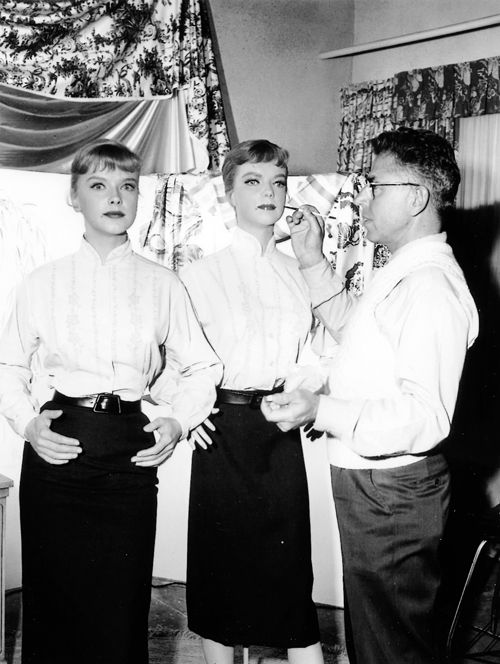
Part 1
The Girl Was a Mannequin
A YEAR or so ago I wrote about The Black Dahlia as something that legitimately happened in history. My conclusion at the time was that Hollywood and the Los Angeles Police Department were in on it. You will have to accept my apologies. Every so often I am dead wrong about one thing or another, and this is one of those occasions. You’re probably wondering why the change of heart. I guess you could say I’ve seen too much. I’ve pulled back far too many curtains and, in doing so, have learned never to trust a conveniently hung drape. The murder of Elizabeth Short was a hoax.
Oh sure, Hollywood and the police were certainly in on it, but so was the girl. Every magician needs an assistant, especially when it comes to the saw in half trick. You see what I mean? We are told Elizabeth Short was an aspiring actress, but that’s not her real name. The implication here is that Elizabeth Short was only a role given to someone in a movie, and I now believe I know who that other person is. In order to learn her true identity, you will have to wait until Part 4. No, I am not being sadistic. There is simply too much to cover in Parts 1 and 2 before we ever get around to the icing on the cake. And really, the Black Dahlia was so much more than a mere role, as we are dealing once again with a home-brewed specialty of Intel. Performance witchcraft.
The Twilight Zone will come to some use, if only in our peripheral vision. There are other Hollywood productions which will need discussed in turn, but there’s an episode of The Twilight Zone in particular titled: The After Hours, wherein we learn that some people are simply mannequins. If I ruined the surprise ending of that episode for you, then you should probably know that I just killed two birds with one stone. It’s another important conclusion of this paper—particularly in Part 2. Try to act surprised when we finally get to it. It originally aired on June 10, 1960, and was written by the show’s creator, Rod Serling. On a side note, Serling was a New York born Joo. Seems only logical that he would be. The thing about mannequins is—they have a doppelganger somewhere in the world. A real person whom they’re modeled after. Again, we’ll get to that. Oh, and another thing. Mannequins are split at the waistline.
I hope you like history, because I’m about to dictate another lesson. The body of Elizabeth Short was discovered on January 15, 1947. In other news, The War was over and Intel needed something to do. The Lookout Mountain movie studio in Laurel Canyon was ramping up their productions, because even spooks gotta eat. Elsewhere, President Truman disbanded the OSS in 1945, but apparently the short-lived Central Intelligence Group, or the CIG if you’re into acronyms, wasn’t making Daddy proud, because they too were traded in for everybody’s favorite Intel group—the CIA. Probably just another good cop bad cop routine. You tell me.
One final comment before continuing. The murdered body of Elizabeth Short will be shown. She may pop up on any given page, and the pictures are graphic. But you probably knew that already. You’ve been warned. Are we simply staring at a mannequin? That is my conclusion. You are free to make up your own mind. But as always, you are under no obligation to believe the official narrative. People are murdered every day in Los Angeles County. Nearly every single victim you’ve never heard about. It is the media’s job to burn every Intel production, including what they were secretly cooking up at Lookout Mountain, into the collective consciousness.
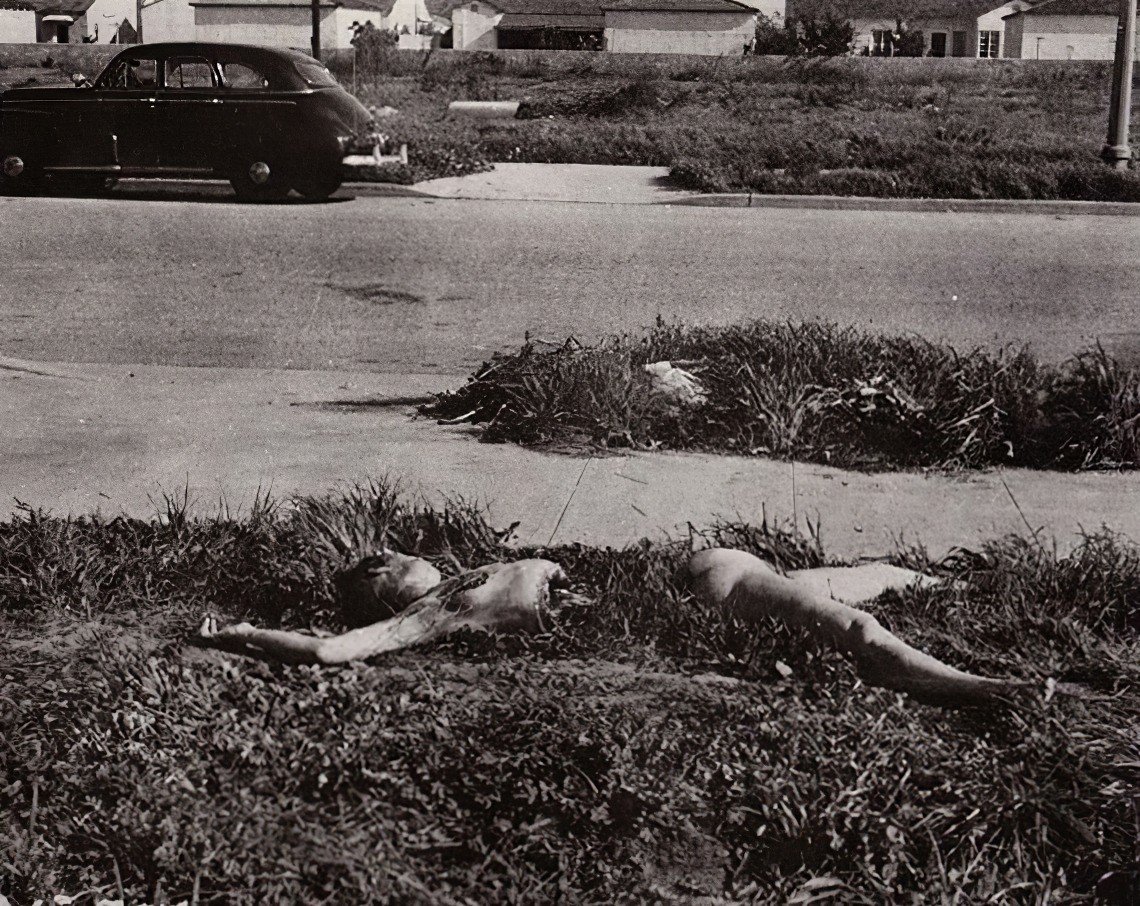
THE WEATHER report for January 15, 1947 casts sunny southern California into a cold, dreary morning. At approximately 10 a.m., Betty Bersinger went walking with her three-year-old daughter through the tree-lined streets of Leimert Park in Los Angeles, angling for the shoe shop. With the outbreak of The War, development had slowed in the City of Angels. Despite Japan’s surrender some seventeen months earlier, entire lots groomed for the suburban sprawl remained abandoned. It was in one such undeveloped field, and only within inches of the sidewalk, that Bersinger stumbled upon what she first described as a discarded mannequin that had been severed in two at the waistline, its lower half positioned a foot away from the upper.
Plant a red flag upon that often-repeated detail. Better yet, I’ve already done it for you. Bersinger is giving us the truth, but then insisting that we deny it. The body of Elizabeth Short was a mannequin. A damn good mannequin, but we’re dealing with the powers that should not be and the back alleyways of Hollywood. What, you don’t think Intel was capable of working with mannequins? I will remind you of Roswell. Read on.
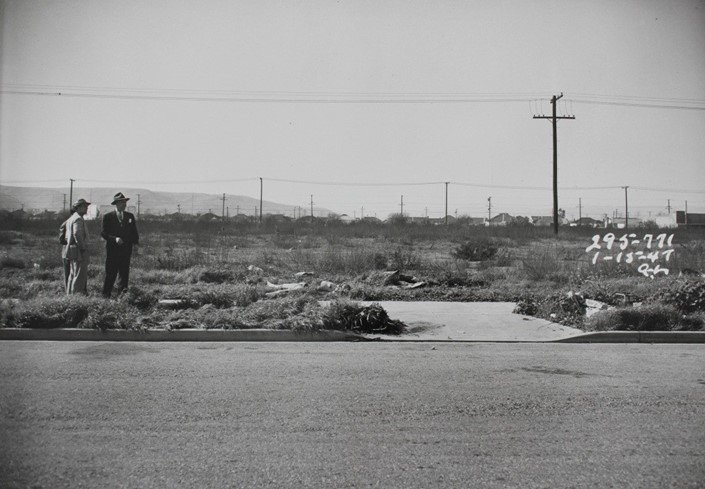
Officers Frank Perkins and Will Fitzgerald arrived on the scene within minutes. The L.A.P.D. followed in their wake. Investigators noted that the woman’s body seemed to have been posed. She was lying on her back with both arms raised above her shoulders, elbow bent at right angles, legs twisted and spread out in a display of seductiveness. Much as one might imagine or position a mannequin. Among numerous other cuts on her thigh and breasts, portions of which were sliced away, Short’s face had been slashed from the corners of her mouth to her ears—creating a look known as the “Glasgow smile.” Mannequin again. Our artist is simply leaving his calling card. In a little while, you shall see who that is.
The most peculiar aspect however is that she’d been completely drained of blood, leaving her skin pallid white. Mm-hmm, you heard that right. White—like a mannequin. And there was no blood at the crime scene. None. Nada. Not even in the weeds below her. You’d think they find something in the way of blood. Anything—but no. Her mortician had taken the time to wash her outside and in, stuff everything back to its proper order, and then carry both ends of her severed corpse to the crime scene undetected, without anything spilling out. Sure.
In a later interview, Bersinger said children rode up and down that street on their bikes in route to school, and she only thought to report the mannequin because they might get spooked. Sure, keep hamming it up, Bersinger. At 10 in the morning, school would have already been in session. Kids had already traversed that street and nobody thought to report a woman cut in two. If the fourth-grade classroom buzzed with talk of the sick looking mannequin down on South Norton Avenue, then we are not told. You’d think insects would be crawling all over her, feasting—but no.
.
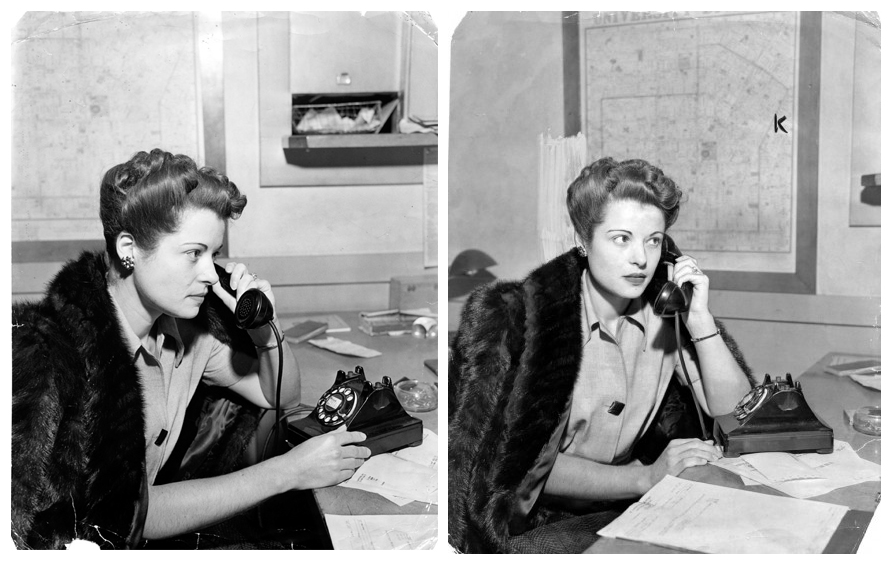
.
WHAT’S this…? Why are there pictures of Betty Bersinger calling the police? Online captions tell us the call regards the woman she discovered in Leimert Park. After fleeing to a nearby neighbor’s house, are we expected to believe that she first hired a camera crew? Looks like her photographer tried various angles, hoping to find Bersinger’s better side. You know, cast her in the right light. Perhaps we are on the set of a John Huston movie. Is that a map of Leimert Park on the wall? Probably trying to perfect her walking route.
The Intel-net explains these photos as Betty Bersinger only reenacting her role, because apparently, dialing up police headquarters or the local Lodge, same thing, leaves much to the imagination. People need to see how Bersinger dialed that very important call, and more than anything, her body posture. Normally, when you discover a discarded body in the field, you call the police, answer a few questions, and then get the hell out of there as quickly as you can, hoping to wash that bad episode from the front burner of your cognition. You don’t buy a mink coat with the money you made on your latest acting gig and make a photo-shoot out of it. This is how crisis actors ensured their part in the newspapers before television became the standard for programming.
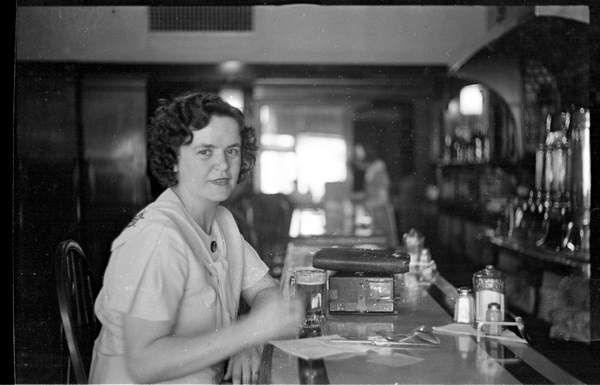
THE FIRST reporter on the scene worked for Randolph Hearst. If you need a refresher, Hearst is the architect of Yellow Journalism, and the 1898 sinking of the U.S.S. Maine in Havana Harbor was a false flag event, but also his Magnum Opus. Hearst literally invented a war and then sold Americans on its legitimacy. Try not to let cognitive dissonance win the day. Elsewhere, we have already seen Hearst and the Hearst family at work in past papers, namely the rape accusation thrust upon Alexander Pantages—a plot cooked up by John and Bobby Kennedy’s father, Joseph P. Kennedy Sr. And secondly, the kidnapping of Patty Hearst, another royally flamboyant hoax. The mannequin murder is one more that you can pile onto that list.
Her name was Agness Underwood. As a first assignment, the Herald-Express had sent her to interview Amelia Earhart. Her first assignment, mind you. This would have been in 1935, when Earhart completed her flight from Honolulu to Oakland. She’d go missing two years later, and that was a hoax. Underwood’s biggest interview to date happened that same year, in 1935, when she hid the alleged murderer Hazel Glab “in her own house until the trial wrapped. And when the verdict came down, Aggie hit the presses with her exclusive interview.”
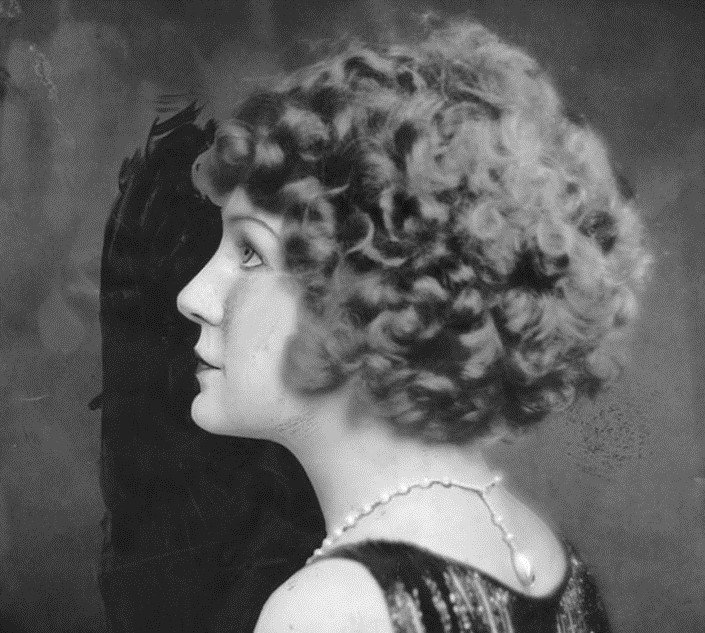 Huh…? Was the Hazel Glab murder trial even real? Glab is listed as a silent film actress, a Chicago bootlegger, and a home entertainer of the Hollywood elite. She danced dancing professionally for a time with Phillip Ainsworth, the former husband of actress and tragic “screen-goddess” Barbara La Marr. She managed much of this while dating William R. McIntire, a Los Angeles cop—whom she also shot in the neck. How do you even hold a murder trial for someone who isn’t present in the courtroom, or in Glab’s case, have their whereabouts unknown? You can’t. And you don’t have journalists harboring murderers simply to grab their scoop, unless that is, you work for Hearst and Hearst is writing the stories. As an added flourish, her daughter’s Girl Scout troop was meeting in the house while Glab hid from authorities.
Huh…? Was the Hazel Glab murder trial even real? Glab is listed as a silent film actress, a Chicago bootlegger, and a home entertainer of the Hollywood elite. She danced dancing professionally for a time with Phillip Ainsworth, the former husband of actress and tragic “screen-goddess” Barbara La Marr. She managed much of this while dating William R. McIntire, a Los Angeles cop—whom she also shot in the neck. How do you even hold a murder trial for someone who isn’t present in the courtroom, or in Glab’s case, have their whereabouts unknown? You can’t. And you don’t have journalists harboring murderers simply to grab their scoop, unless that is, you work for Hearst and Hearst is writing the stories. As an added flourish, her daughter’s Girl Scout troop was meeting in the house while Glab hid from authorities.
Underwood would then report on nearly every major murder case in the city, but in 1947, Elizabeth Short was her biggest story to date. Who came up with the name Black Dahlia? Underwood did. Also, who solved the case? Underwood again. You see, Black Dahlia was Agness Underwood’s final case. According to Underwood, she was “pulled from reporting on the case twice, each time without warning, or explanation.” She was then informed that her new assignment was a promotion to the city editor of the Herald-Express. Not too shabby.
The Media would have you think that Agness Underwood was removed on the basis that she was too good of a reporter. That she discovered who the killer was and needed to be shut up. But that makes no sense whatsoever. Underwood never once insinuated that anyone threatened her. The police sure weren’t interested in finding out what she knew, but that’s a given. Many years after the Dahlia case went cold (it was always intended to), Aggie told her children and grandchildren that she knew who had murdered Elizabeth Short. When asked for the name of the killer, all she would say was: “He’s dead and it doesn’t matter anymore.” Sure, let’s go with that.
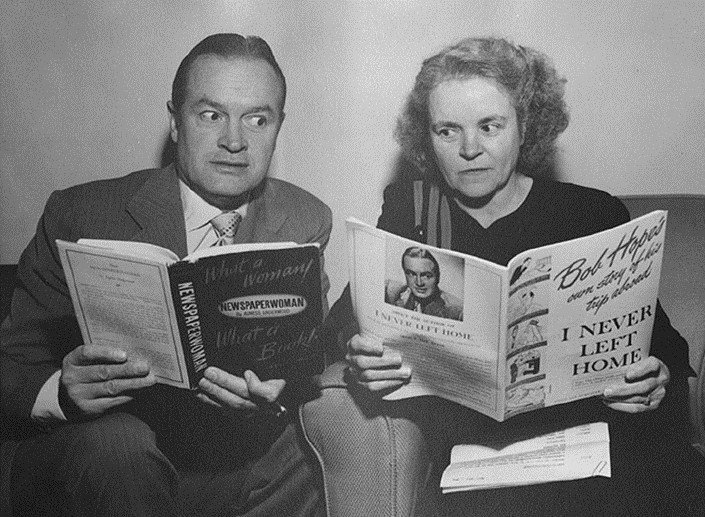
Underwood was simply attempting to let her children know that they were uninitiated, and therefore couldn’t be let in on the nature of the beast. Namely, her employer. That she loved creating stories just as much as Hearst did, and just as importantly, that she was in on the hoax. Just look at Underwood hanging out with Bob Hope. He’s not sure if she knows but she’s not sure if she should tell him that she does know, just perhaps not the same thing. How awkward. It’s a boy’s club and secret society thing. Look, you don’t get to swap books with Bob Hope and play the game of shifty-eyes unless you’re in the know about something. Underwood did her time, received her reward, and if she was pulled halfway through the swan song, it was only to enhance the psychodrama. And here we are, some 75 years later, still trying to figure out what the hell happened. See what I mean? The performance still has magic left to it.
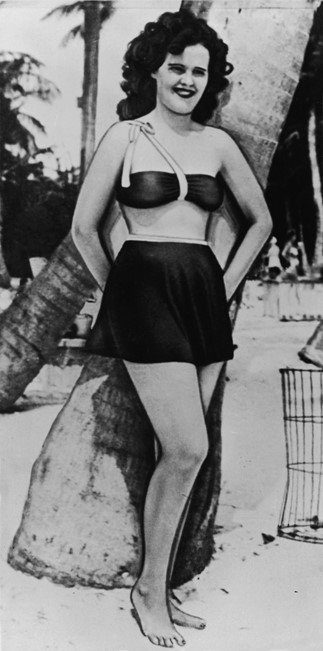
THE REASON I ultimately decided to take another look into the murder of Elizabeth Short probably has something to do with my haphazardly stumbling upon this photo on the Intel-net. We are told Elizabeth Short is at “the beach” sometime in 1945, less than two years before her murder, but look closely. See the black line etched around the entire frame of her body? It runs alongside her legs, her shoulders, arms and ribs, even her feet. It’s a fake.
Didn’t the killer send numerous letters to the press using only newspaper cut-outs glued onto paper? He did. We haven’t gotten that far yet, but I get the feeling that the same creative department had a hand in her beach photo.
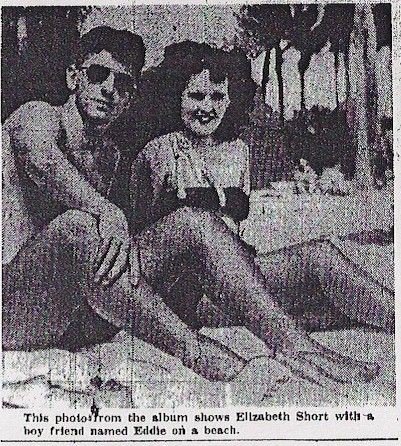
There’s another beach photo of Elizabeth Short. Same bathing suit. Perhaps same location, but hard to tell. Only here she can be seen sitting down with some guy named Eddie. Intel didn’t come up with a full character name for the boyfriend. He’s simply Eddie. For all I know, he’s with the General Intelligence Directorate. That would be the Egyptian secret service. You’ll know what I’m getting at when this is over. Once again, we’re looking at another fake. It’s just as fake as the first. Same black lines dominate Eddie. Really, they should have left the first image of Elizabeth Short standing next to a palm in just as low of quality, or else I might have never noticed.
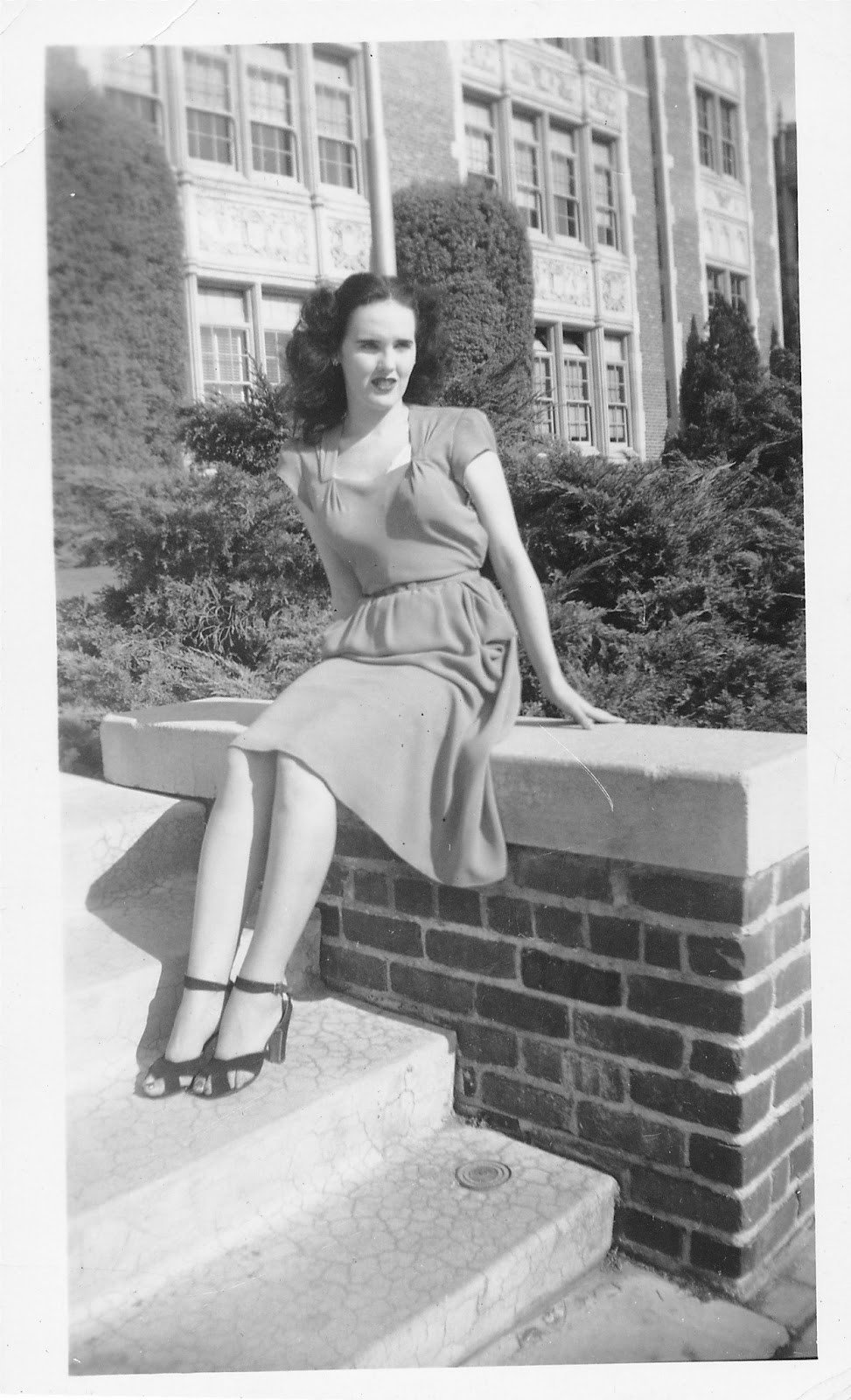
To be clear, there are un-doctored pictures of Elizabeth Short. She was 22 while posing for a photo-shoot in front of John Marshall High School. Take a note of her age, but also the name of the school. Getting in character, I see. Ready for the big day. Short was murdered within a few short months, perhaps weeks afterwards. Still uncomfortable though, as her body posture shows. But once you learn who Short truly is, you’ll see for yourself that she was almost always a stiff around the camera. There are several pictures from her trip to John Marshall making the rounds online. I chose this one but they’re all essentially the same. Awkward—as modeling goes. The photographer probably unloaded a role and then printed the few where Short managed not to squint her eyes. Then again, not even the photographer had any style—telling us he was an amateur at best or only pretending to be one. Go ahead. Do an Intel-net search on John Marshall High School. The campus has character. It’s brimming with it. All one needs to do is point the lens at the front facade and, should even his trigger finger have a smidgen of talent, the artistry will present itself, regardless of his actor.
22. That’s how old Elizabeth Short was when she died. They like to slip 22 in there because it designates Short as “the Master Builder.” Wink-wink. You see, 2 and 2 makes 4, which signifies a human construct which is “fixed and squared.” Again—when Shaggy, Scooby Doo and the gang finally unmask Elizabeth Short, you will see what I mean.
The school was named after the Chief Justice of the United States Supreme Court. He was also a Freemason. But not just any Freemason. Starting in 1793, Marshall served as the Grand Master of the Grand Lodge of Virginia. In 1807, Marshall was called to preside over the Aaron Burr trial. It was a fake trial, because the shooting of Alexander Hamilton was a hoax. And anyways, The Black Dahlia was a movie. The woman playing Elizabeth Short was posing on a movie set. Because that’s what John Marshall High School ultimately is. A movie set.
An online search for John Marshall High School as a shooting location delivers the following productions. Try not to drool. Grease, Rebel without a Cause, The Wonder Years, Boy Meets World, Growing Pains, Pretty in Pink, Uncle Buck, Bachelor Party, A Nightmare on Elm Street, Space Jam, Buffy the Vampire Slayer, Can’t Hardly Wait, Grosse Pointe Blank, Simon & Simon, Highway to Heaven, Mr. Novak, The A-Team, Big Bang Theory, Girls Just Want to Have Fun, and that Van Halen music video, Hot for Teacher.
Elizabeth Short standing in front of John Marshall may have been chosen as a promotional shoot, wherein the message was made clear among other spooks. The Black Dahlia production is a go.
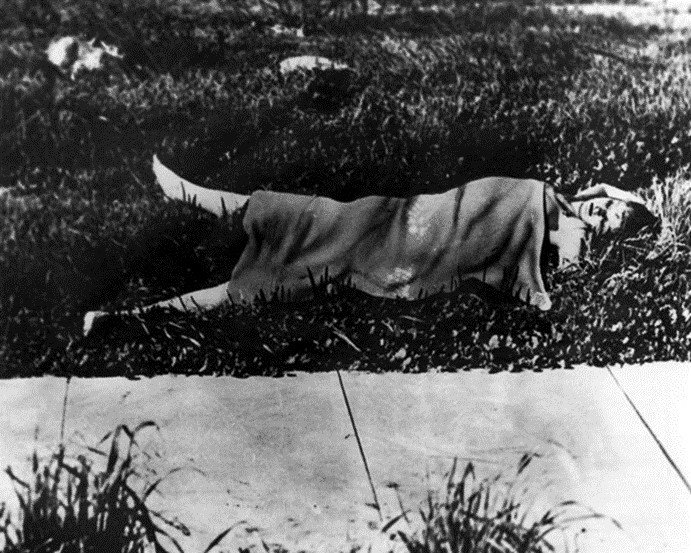
GETTING back to the doctored photos. Here we can see a photo of Elizabeth Short, reportedly taken at the crime scene. Her body is—as you already know—sawn in half, but it is terribly difficult to tell with the blanket covering her. It was the very first photo of Elizabeth Short printed up in the press. And who printed it? You are correct if your guess was the Herald Examiner.
You will tell me they covered a blanket over her body for modesty purposes, as they would not otherwise be capable of publishing the photo for the general public. Why not just blur the body out then? Or better yet, show it from a clever angle. The blanket is fake. Nobody added a blanket to the body of Elizabeth Short at the crime scene. Her covering is given to us, courtesy of the boys down at The Lab. But that’s not the only fakery applied to it. Elizabeth Short’s face was manipulated. Where is the “Glasgow smile?” Whose lips are those? That’s not even her eyes and nose. The mutilations have been completely scrubbed to such a degree that we’re no longer looking at Short’s face. It’s another imaginative recreation.
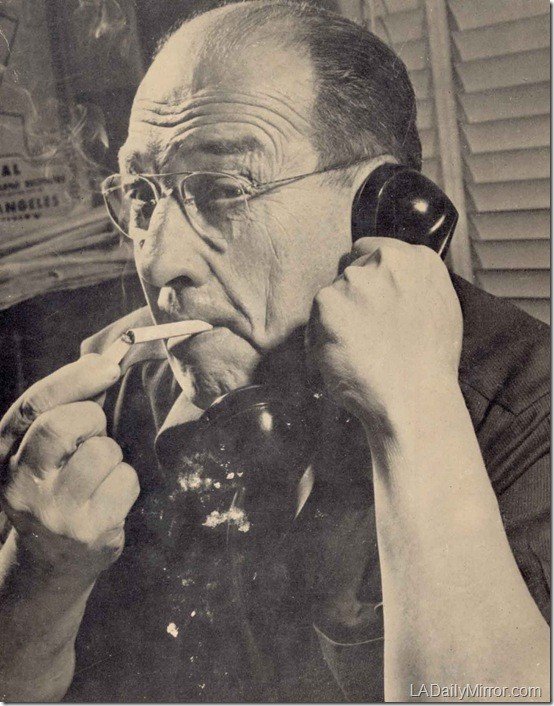
The imaginative artist was none other than Hearst’s right-hand propaganda man, Howard Burke. Here we see a picture of Burke, probably taking a call from the OSS. Receiving details on who was supposed to sink our next ship. You see, after the false flag sinking of the U.S.S. Maine in Havana Harbor that initiated Intel’s century-long false narrative in Cuba, Hearst decided a war with Japan might be a good thing. His newspaper war with the Empire stared in 1906, lasting 35 years until the bombing of Pearl Harbor. Sure, Hearst didn’t coin the phrase yellow peril, just as he didn’t create the tactics to yellow journalism, but he mastered both early on. Regarding the former, his very first article arrived in 1907, proclaiming: “The Yellow Peril is here.” His attacks continued during the First World War, even while Japan aligned with the allies against Germany. The yellow peril rhetoric then continued after the war, culminating with a motion picture. By 1933, TIME Magazine noted that “The Yellow Peril has for 30 years been a great circulation-getter for the Hearst papers.”
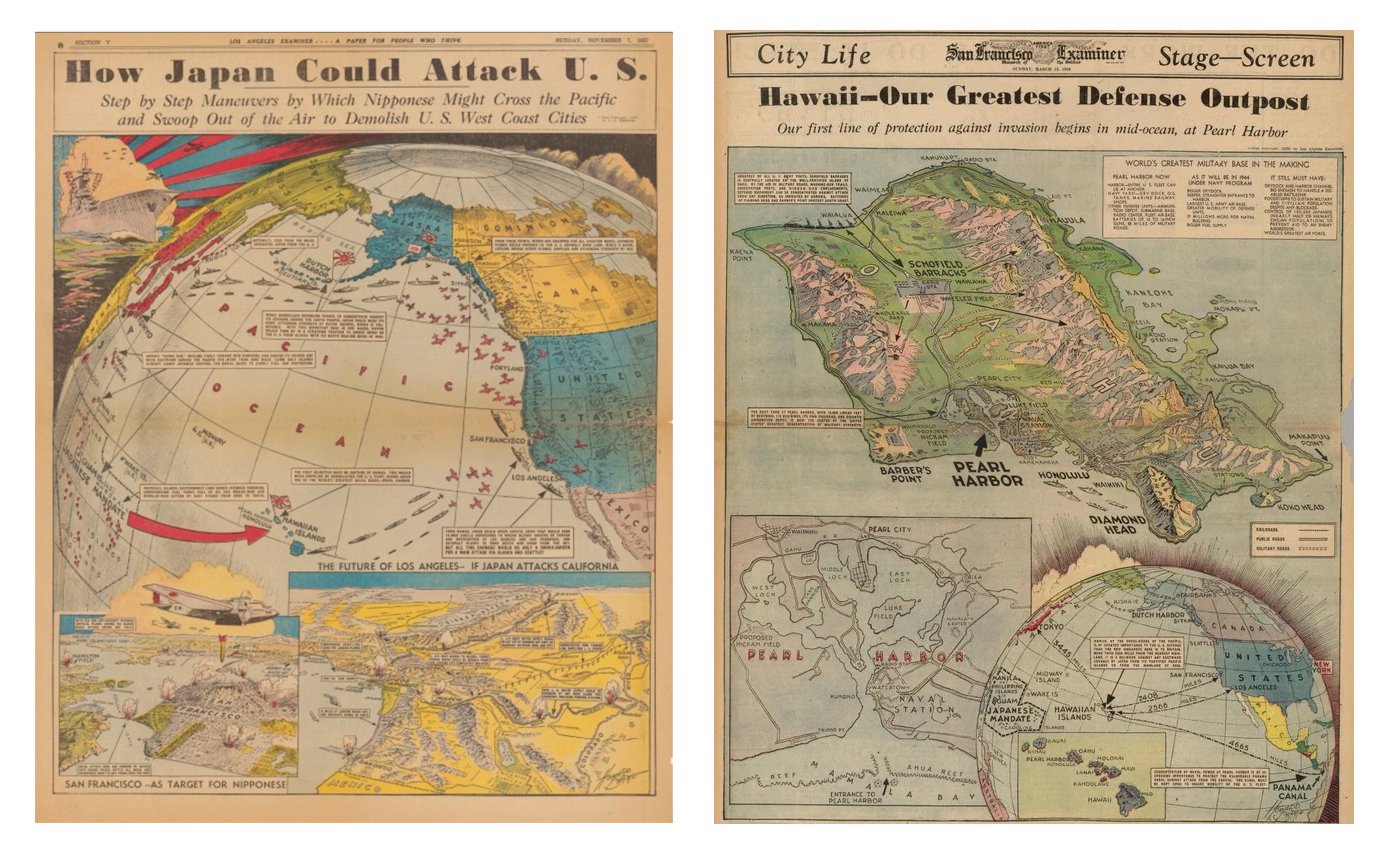
If Howard Burke’s part in the propaganda wasn’t predictive programming, then I don’t know what else is. The War would not begin in Europe until September of 1939. Japan would not bomb Pearl Harbor until December of 1941. And yet, here we see two full-page illustrations drawn by Burke in 1937 for the Los Angeles Examiner, telling us precisely how Japan would draw us into The War. Technically, in the first image, Burke has San Francisco being bombed—telling us that one of Intel’s favored psyop cities was at one time considered. It’s not like they didn’t have a part in its 1906 destruction. But notice he has drawn an arrow directly to Hawaii. Mm-hmm. Hawaii has always had a part to play in the drama.
His second sketch was published in 1938, thereby saving Japan a lot of Intel work, don’t you think? Probably not the best idea to publish a detailed map of your “Greatest Defense Outpost,” complete with precise locations of barracks, forts, harbors, runways, shipping lanes, radio towers, and anti-aircraft gun emplacements, but what do I know? Just goes to show that the Media’s job is creating the news. Wink–wink.
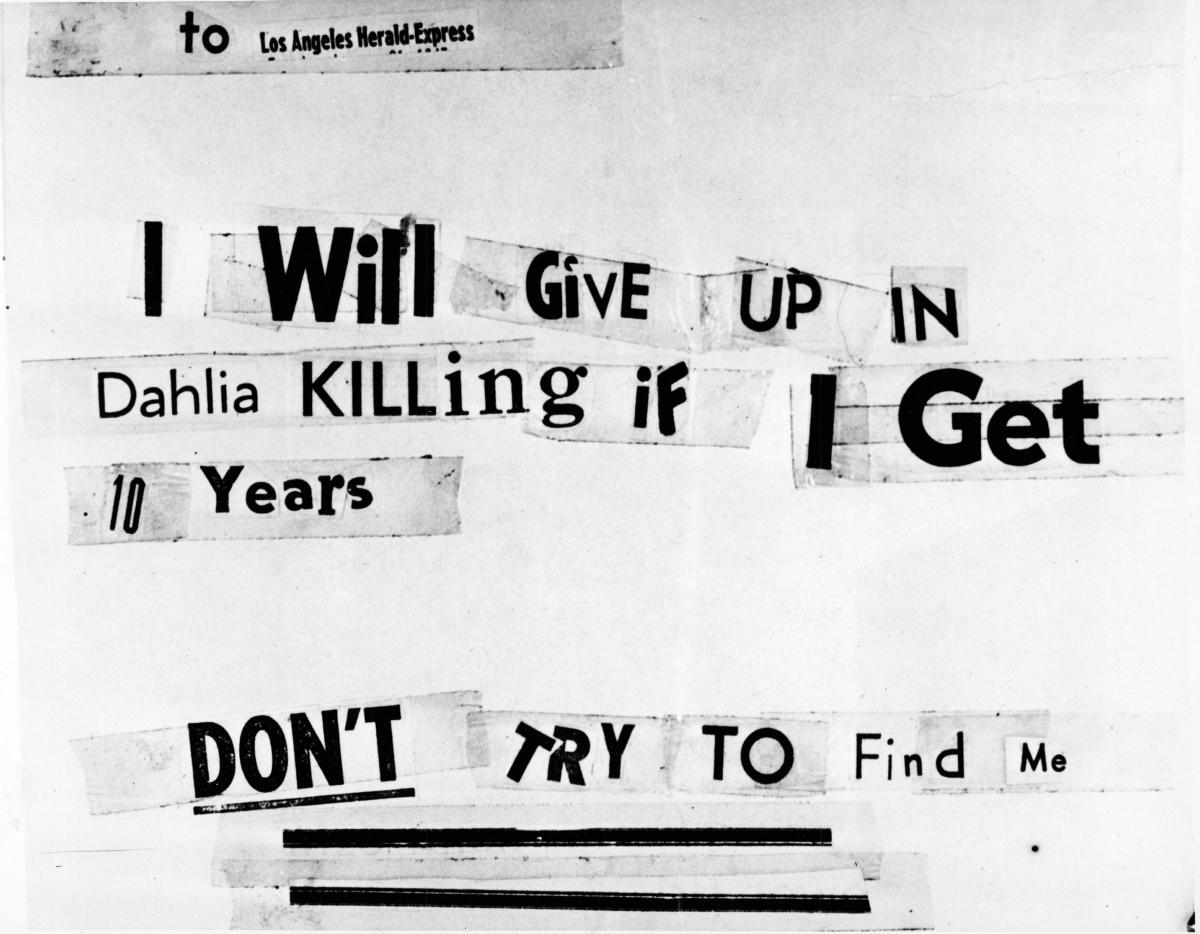
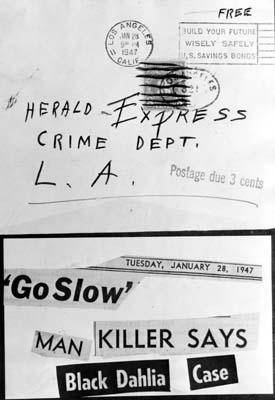
FROM the very start of the investigation, we are told the LAPD was forced to form a symbiotic relationship with William Randolph Heart in order to solve the crime. Wow, this movie is really getting good. Too bad it got snubbed by the Academy. Hearst’s proposal to the police was that he would share crucial information, essentially all information that his team of reporters had uncovered, if the LAPD would grant exclusives in return. LAPD Homicide Investigator Captain Donahoe grudgingly accepted the terms. Suck it up, Donahoe.
On January 21, less than one week after the murder, The Examiner received their first big clue. Oh gee, is it the killer stoking his ego? Uh-huh. It is. A person claiming to be Short’s killer placed a phone call to the office of James Richardson, newspaper editor, in order to personally congratulate him on their coverage. Probably rubbing one off as he did so. He then stated that he planned on eventually turning himself in, but not before allowing police to pursue him further as some sort of cat and mouse game. In order to prove his claim, the caller additionally told Richardson to “expect some souvenirs of Beth Short in the mail.” One can only wonder if the caller had a good view of the reflection pool from his office in the Munitions Building, Washington. Probably practiced his best James Cagney impression in-between bites of his ham and cheese sandwich before finally dialing Richardson. You dirty rat. No, wait. You dirty—you dirty rat.
Apparently, despite wanting police Investigators to chase his tail, the killer had already cleverly figured out that Hearst was working with the LAPD, which is why his package, an “overly suspicious” manila envelope—complete with individual words cut and pasted from newspaper clippings—was addressed to the Los Angeles Examiner rather than the buttons. It arrived on January 24, three days after the phone call. You figure it would take that long for the package to travel across the country after being dropped off at some random mailbox near the corners of 20th Street and Constitution Avenue. Or perhaps we’re simply reading the artistic stylings of Howard Burke.
The envelope contained Short’s birth certificate, business cards, photographs, random names written on pieces of paper, and an address book with the name Mark Hansen embossed on the cover. Who is Mark Hansen? Just one of dozens upon dozens of potential suspects. Specifically, he was a nightclub owner. Why would Intel send an address book? To tell you who the other scripted players are. It seems like everyone involved was vying to be included with the clues. The care package had been carefully cleaned with gasoline, just as Short’s body had, directing police to their next clue—that the package had been sent by the killer. Regardless, prints were lifted. Uh-oh. In return, Investigators sent the packet right back to Washington, this time to the FBI building, hoping for print identification. Here The Wikipedia adds: “However, the prints were compromised in transit and thus could not be properly analyzed.” Oh, say it ain’t so. The Intel agent’s identity was spared. That must have been such a relief.
There were more letters. Some of them went to other newspapers, but the killer had a penchant for The Herald Express and The Examiner, obviously, seeing as how Hearst was such a bad ass and Captain Donahoe probably couldn’t head up an actual murder investigation if his career depended upon it. One of these letters to Hearst even read, “I will give up in Dahlia killing if I get 10 years. Don’t try to find me.”
So, does the killer want to be found or not? So confusing. The sheer number of letters which began pouring in would secure the fact that we’re dealing with the most convoluted and confusing game of peek-a-boo ever, as it was always intended to be. Clearly, the investigation was designed for public consumption from the very get-go, the procedural motions was a well-oiled script, and I’ve probably mentioned this already, but the killer was never intended to be found. Intel wanted a P.I. novel whereas everyone guessed who the killer was without ever getting around to writing the final paragraph. There is no big reveal. In that way, the story never really ends. It just goes on and on, and we are left to guessing. Which is why we still find ourselves in it today. The alchemical juices are still cooking.
In the second part, we will take a look at some of those suspects. They’re really just actors. At least, most of them are. There is one suspect in particular who was too good of an actor, as the world came to know him by another name. Like the real Elizabeth Short, he too will be unmasked. As usual, I will try my darndest to report the proceedings without rolling my eyes. If only you could see my computer screen. Cracked. Probably from so many pendulum swings of sarcasm. It comes with the profession.
Noel